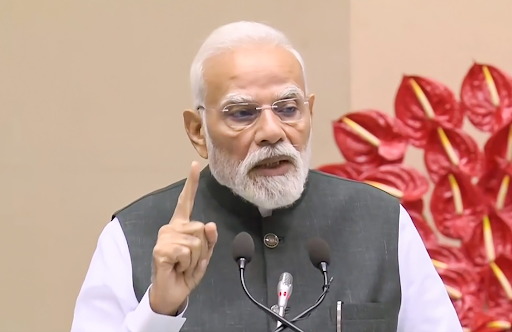Description

Copyright infringement is not intended
Context: Then Union Communication Minister inaugurated seminar on “25 Years of TRAI Act: The Way Forward for Stakeholders’.
Details:
- Telecom Disputes Settlement and Appellate Tribunal (TDSAT) organized a seminar on “25 Years of TRAI Act: Way Forward for Stakeholders (Telecom, Broadcasting, IT, AERA and Aadhar)”.
- The seminar was inaugurated by the Union Minister for Communications to honor the 25 years long journey of Telecom Regulatory Authority of India (TRAI) Act.
Telecom Regulatory Authority of India:
- In the year 1997, TRAI Act was enacted to regulate the telecommunications sector in India.
- It also provided for a mechanism of dispute resolution among the stakeholders of the telecom sector.
- It was amended in 2000, establishing a Telecom Disputes Settlement and Appellate Tribunal (TDSAT) to take over the adjudicatory and disputes functions from TRAI.
Telecom Regulatory Structure in India:
- Telecommunications in India began as a Government monopoly, which was then liberalized in the early 1990s and private sector participation was permitted gradually.
- Major parties in the Indian telecom market include BSNL (Bharat Sanchar Nigam Limited), Bharti Airtel, Vodafone Idea Limited, and Reliance Jio Infocomm.
- National Telecom Policy, 1994, allowed entry of private entities in the telecom sector and with entry of the private sector, the need was felt to have a regulator for this sector.
- Establishment of Telecom Regulatory Authority of India in 1997 through enactment of TRAI Act. Initially, TRAI played the role of regulator as well as adjudicator.
- The TRAI Act was amended, and established a Telecom Disputes Settlement and Appellate Tribunal (TDSAT) to take over the adjudicatory and disputes functions from TRAI.
- The Ministry of Communications and Information Technology presides over the telecom industry in India and governs the following bodies:
- The Department of Telecommunications exercises its exclusive privilege establishing, maintaining, and working telegraph and wireless equipment and grants Licenses for such activities.
- Wireless Planning Commission (WPC) responsible for Frequency Spectrum Management, including licensing of wireless stations and caters to the needs of all wireless users in India.
- Telecom Regulatory Authority of India (TRAI) is an autonomous statutory body with the sole authority to take binding decisions on the fixation of tariffs for the provision of telecommunications services. TRAI’s recommendations are mandatory for the DoT to consider before licensing telecom services.
- Telecom Disputes Settlement and Appellate Tribunal has been vested with exclusive powers to adjudicate any dispute between the licensor (DoT) and a licensee; service providers; and service providers and groups of customers.
Telecommunications Laws and Regulations:
- The Indian Telegraph Act, 1885
- It empowers the Government of India to take control of the existing telegraph lines and lay down the necessary infrastructure for further expansion of telecommunications in India.
- It authorizes the Government of India to grant telecom Licenses on such conditions and in consideration of such payments as it thinks fit, to any person to establish, maintain, and work a telegraph within any part of India.
- It authorizes the Government of India to take possession of licensed telegraphs and to order interception of messages on the occurrence of any public emergency or in the interest of public safety.
- Any dispute concerning a telegraphic appliance/ apparatus/ line between the telegraph authority and a licensee shall be determined by arbitration by an arbitrator appointed by the Central Government.
- The Telecom Regulatory Authority of India Act, 1997
- The Telecom Regulatory Authority of India was established under the Telecom Regulatory Authority of India Act, 1997.
- It empowered the TRAI with quasi-judicial authority to adjudicate upon and settle telecom disputes.
- The Act was amended in 2000 to clearly distinguish between the regulatory and recommendatory functions of TRAI. The Amendment also set up the TDSAT; jurisdiction of civil courts.
- The Information Technology Act, 2000
- The Act was passed to promote e-commerce, to legally recognize electronic documents and digital signatures as valid authentication of electronic documents.
- The Information Technology Amendment Act of 2008
- It provided additional focus on information security and added several new sections on offences such as cyber terrorism and data protection.
- It provides penalties for various offences such as cybercrime, e-commerce frauds such as cheating by impersonation, and pornography.
- National Digital Communications Policy, 2018
- The National Digital Communications Policy (NDCP) was enacted with the goal of digital empowerment and well-being of Indian citizens; it outlines a set of goals, initiatives, strategies, and intended policy outcomes.
- Provisioning of Broadband for All by 2022.
- Creating four million additional jobs in the digital communications sector by 2022.
Aim of India’s Communication Policy:
- Connect India: Creating robust digital communications infrastructure to promote ‘Broadband for All’ as a tool for socio-economic development, while ensuring service quality and environmental sustainability.
- Secure India: Ensuring sovereignty, safety, and security of digital communications to secure the interests of citizens and safeguard the digital sovereignty of India with a focus on ensuring individual autonomy and choice, data ownership, privacy, and other Future Technologies.
- Innovate India: Promoting next-generation technologies and services through investments, innovation, and intellectual property rights (IPR) generation to harness the power of emerging digital technologies, including 5G, AI, IoT, cloud, and big data to enable the provision of future-ready products and services.
https://newsonair.gov.in/News?title=Communication-Minister-Ashwini-Vaishnaw-inaugurates-seminar-on-25-Years-of-TRAI-Act%3a-The-Way-Forward-for-Stakeholders&id=437095










